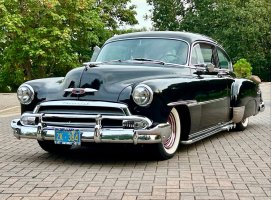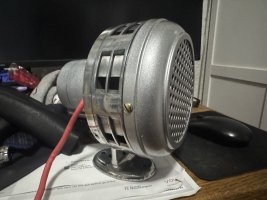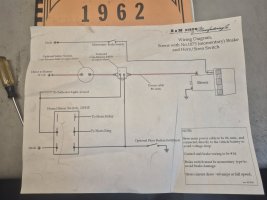I am an old (61) new guy entering the old school classic car scene. I have a 1951 Chevy Fleetline and got the bug to install a Federal Model O siren in it. I am wondering if you could help me out with a wiring diagram? I bought a Ford solenoid, wiring for both a positive and negative, the switch and the relay. I think all I need to do is figure out the placement and wiring and I will be GOLDEN... I should have prefaced this message with... I never grew up working on cars and usually have someone else work on them. This is my first classic car. Any help would be greatly appreciated!!
You are using an out of date browser. It may not display this or other websites correctly.
You should upgrade or use an alternative browser.
You should upgrade or use an alternative browser.
How to wire a Federal
- Thread starter Tracy Lundin
- Start date
Simple wiring + battery post to solenoid big post, other big post to siren. Now hard part what kind of switch do you want? There is a floor mount monetary on, a push button on the dash or a flip switch so you can operate it off your horn button. Both the push button and floor switch are simple plush on make noise let off quit. Your solenoid will be either 3 or 4 post. Two little two big. you all ready did the big one #4 wire at least bigger if it 6 volt . So now to wire the trip. Hot on hot or with switch on, your choice. It Goes to one side of switch. other side to small post on solenoid. If 3 wire it grounds threw the mount. if 4 run a ground off other side . If you want it to go threw the horn button it takes a double pole double throw switch . Splice the wire going out to the horn to one side of the switch. Then jump the side that comes from the steering column to the other side of the switch. the last post will go out to the solenoid. Not you flip the switch one way press the horn button and the horn honks. Throw it the other way and press the horn button the siren screams. Good luck.
Last edited:
What you need is a constant duty solenoid, not a Ford starter solenoid. It isn't rated for constant duty. Wiring isn't much of a problem if you have the proper equipment and tools. Is your car still a 6-volt system, or has it been changed to 12 volts? You will need the largest ampere-hour battery that you can fit into the battery box. Do you want to control the siren from the horn ring, foot pedal, or a button on the dash? The general principles will remain the same; however, their application will vary. Do you have a siren model in mind? One thing to consider is where you want the siren to be mounted. Your car looks like it would make a perfect "police car" clone. You could also build it like a detective car.
I neglected to add that the car has been changed to 12v. The siren is also a 12V. The siren is a Federal model 0, but I think the face cover has been swapped. I would love it if I could use the horn button, but that might be too much for me. I do have a car builder who may be able to show me or guide me through it. The plan is to put the siren between the radiator and the grill on the passenger side of the vehicle. There is enough room for it there. Otherwise, I was thinking about relocating the battery to the trunk and putting the siren on the battery box. That would be the ideal location. But that is a lot of work. The other thing I am thinking about is buying cloth-covered wiring so it looks like it came that way from the factory. Do you think 12-gauge wire would work for that? I know a lot of questions, but I want this to be something I don't want to worry about. Thanks for all your help!!
Attachments
A vintage 12-volt Federal Sign & Signal Model 0 siren, the current draw is around 75 amps on startup and drops to approximately 50 amps during operation. The initial 75-amp draw is required to spin the siren up to its operational speed. You are going to need a wire such as a rubber coated piece of stranded welding wire that will be tied into teh positive battery cable going to the Cole Hersee switch and then to the siren. The reason for using 2.0 copper welding cable is that it is made up of very thin, but an extremely high number count of copper wires. This is better for delivering the amps necessary to use that siren. It is also very flexible. If you want to make the wire look like the original wiring of the vehicle, you can encase the wire in asphalt coated cloth wire loom. You can get the supplies from Rhode Island Wiring (https://www.riwire.com) and click on "supplies", and then Plastic and Cotton Braided Battery Cable. I would also recommend that you consider upgrading your alternator, or buying a jump pack to get the car started when the battery dies from using the siren. You will also need a 900 or high ampere hour battery to keep everything going. Reliving your childhood isn't inexpensive!
If you decide to go through with the project I can put together a wiring schematic and material list for you.
Paul
If you decide to go through with the project I can put together a wiring schematic and material list for you.
Paul
I appreciate all your help with this matter! I am doing a little research on the products you mentioned... You are right, it isn't inexpensive! I would appreciate a wiring schematic and a material list from you. It will give me a good place to start. I guess I will need to work a little more OT so my wife won't be too upset with me. LOL!!
I am thinking about running the switch through the horn, but not sure I can pull that off.
I am thinking about running the switch through the horn, but not sure I can pull that off.
Going threw the horn to trip it is simple pick up the double pole double throw switch. It will have 4 posts on the bottom now just draw this out on paper. Take the main wire going to the horns. Cut it. Now you have 2 wires. splice them with the same size wire . The one going back to the fire wall is the control wire. Label it with a piece of tape. hook booth wires to one end of the switch. If memory serves me correct position the toggle so that it points away from your wires. Test the horn. If it honked good. if not throw the toggle the other direction and test again. If no horn ,did you turn the key on? Now we have a horn. Take a jumper wire from your labeled wire to a post on the other side. Then from the other post goes to the trip post on your solenoid. If it has one post it grounds threw the base if there are two small posts the other side goes to ground. This is how it workes. There is a hot wire that goes up the steering column. It rides on a insulated slip ring on the wheel. You press the horn button and it makes contact with the wire you just spliced. And now controls which way you have the switch throwen. Horn or siren.




